Call it The City of the Lion or an Asian Tiger, a westernized country or an oriental melting pot, either way Singapore undoubtedly is a cosmopolitan city-state, a place where different cultures, interests and traditions blend together and where aspirations, wishes and dreams – even those that are better left unsaid…! – come true.
We ought to remember that cosmopolitanism is never hassle-free nor disappointing. The disappointment of the blue-collars for instance, who account for a good half of the population and that cannot afford an accommodation in the city. This working class is therefore compelled twice a day to join a crowd of hundreds of thousands of people that every dawn and every dusk queue for never ending hours at the custom to Malesia to cross the border on their own feet through the strict of Johor.
Not to mention the frictions between the descent of Chinese, Malay, Indian and Indonesian who at the beginning of the XIX Century, merged at the extreme south of Malaysia and populated the commercial outpost founded under the British protectorate of the English Company of East Indies, nowadays developed in one of the most important harbours worldwide.
Leaving in the shadow the sad real lives of the poorest working class, the most prominent image of the city is given by those that flaunt their richness and, if you believe that in 2009 Singapore was classified as the metropolis with the highest density of resident billionaires, then they account for a good number! The city of Singapore offers to the white-collars high wages, efficient public transports and the greatest choice of entertainments; the whole Sentosa island is a fun fair, both for kids and the grown-ups.
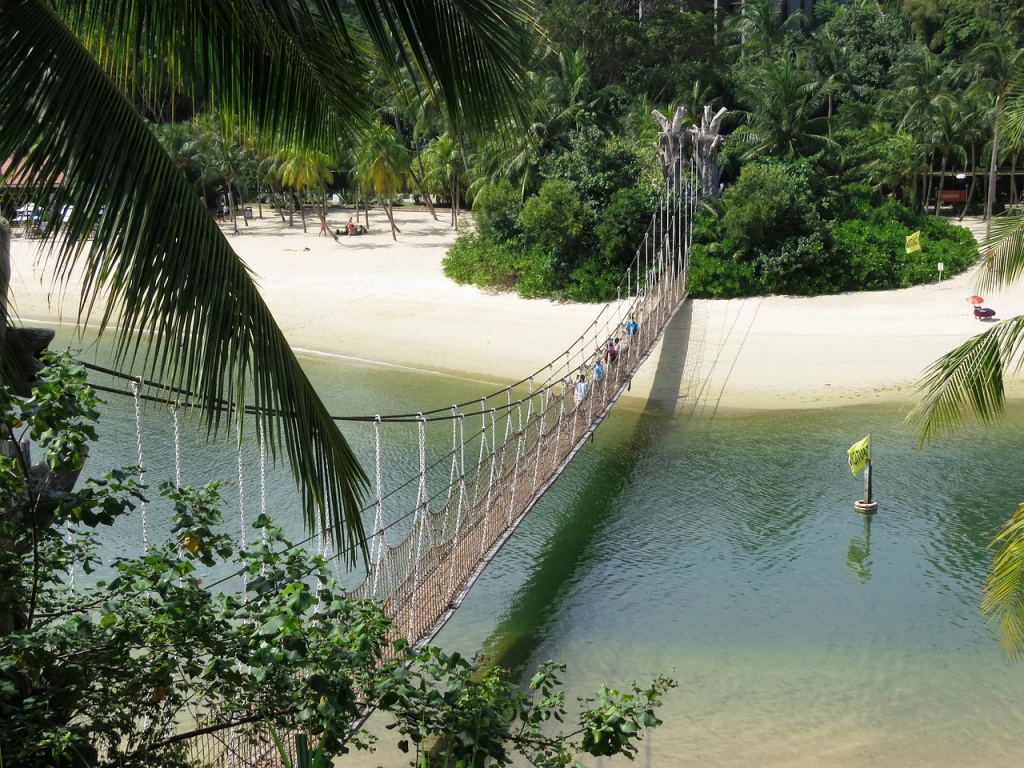
The heat of the tropical climate is cooled down by the shades of futuristic skyscrapers, by the urban parks, which are real tropical forests and the luxurious Botanic Gardens. The city seduces and enchants with the power of its visionary landmark, such as the Marina Bay Sands area, planned by Moshe Safdie and rendered popular worldwide by the longest and highest infinity pool, or the museum of ArtScience, realized in the shape of a flower. The municipal government takes care of the tranquillity and safety of its citizens by imposing severe behavioural rules: capital punishment is applied to major crimes and drug trafficking, while hefty fines are for those caught walking naked in their own apartments or do not flush the toilet! Not unusual to hear Singaporeans or resident expats shouting loud how privileged they are in living in the city of Singapore. Their content is so high that they do not feel the need to travel not even for tourism anywhere else in the world, proudly stating they would never leave Singapore for anything in the world as they already have everything they need. They seem to be fully satisfied to live a life that, thinking carefully, might closely resemble the one of Truman Burbank in the movie “The Truman Show”.
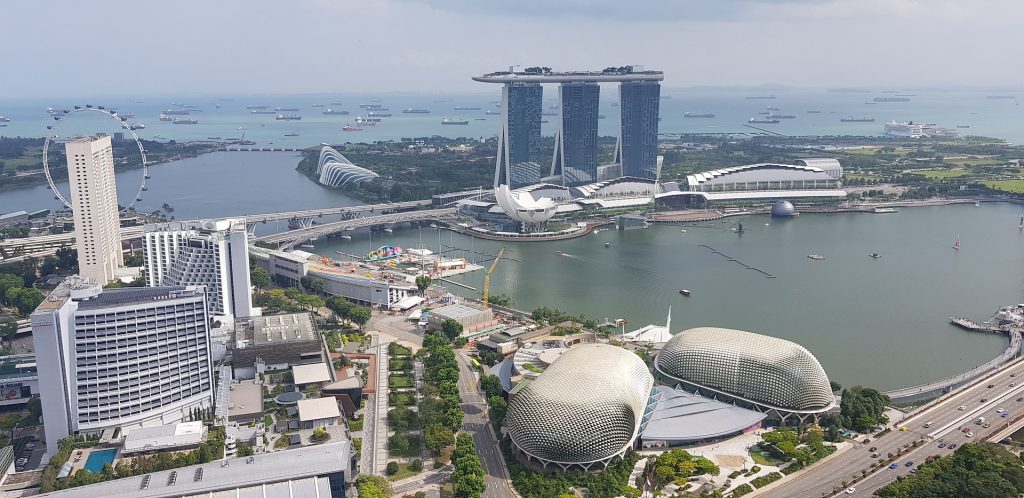
As unfortunately often occurs in many main capital cities, the portrait of Singapore is engraved with a deep fracture between the wealthy middle-class and the poor working-class, further exacerbated by the multi-ethnicity of the population. But good news is that, sometimes, from the most extreme situations, the most extraordinary and unexpected miracles happen. And it is the case to say that, here, the miracle was realized by the cuisine!
Although the city is one of the most expensive in the world, it is surprising to find that eating out turns out is very cheap, even cheaper than home cooking. The phenomenon is due to the many food courts, that can be found anywhere in the city, filled with closet-sized stalls selling street food. At any time, between 11 a.m. and 11 p.m. noodles, soups, rice, ravioli, kebabs are available for purchase; as well as grilled, steamed and fried food; freshly squeezed fruit juice, sweets and fruit.
Since the ’60 – when Singapore became an independent Republic – the phenomenon of street food has been under the regulations of the municipal government. The street stalls, often lacking running water and electricity, had very precarious hygienic and sanitary conditions; rubbish, stray animals, rodents and parasites contributed to make the situation worse. Alongside the introduction of high-quality standards, the government built the so-called Hawker Centers, dislocated in several parts of the city. These food courts were specifically designed to enclose street stalls and were equipped with toilets, tables and shared eating areas for customers. Every day, a multitude of people, ranking from the poorest to the wealthiest, from workers to tourists, goes to the Hawker Centers of Singapore. Here, for a few Singaporean dollars, you can pick your favourite food with plenty of choice off the multi-ethnic stalls and sit in the shared tables, enjoying your meal surrounded by many other customers and passers-by.
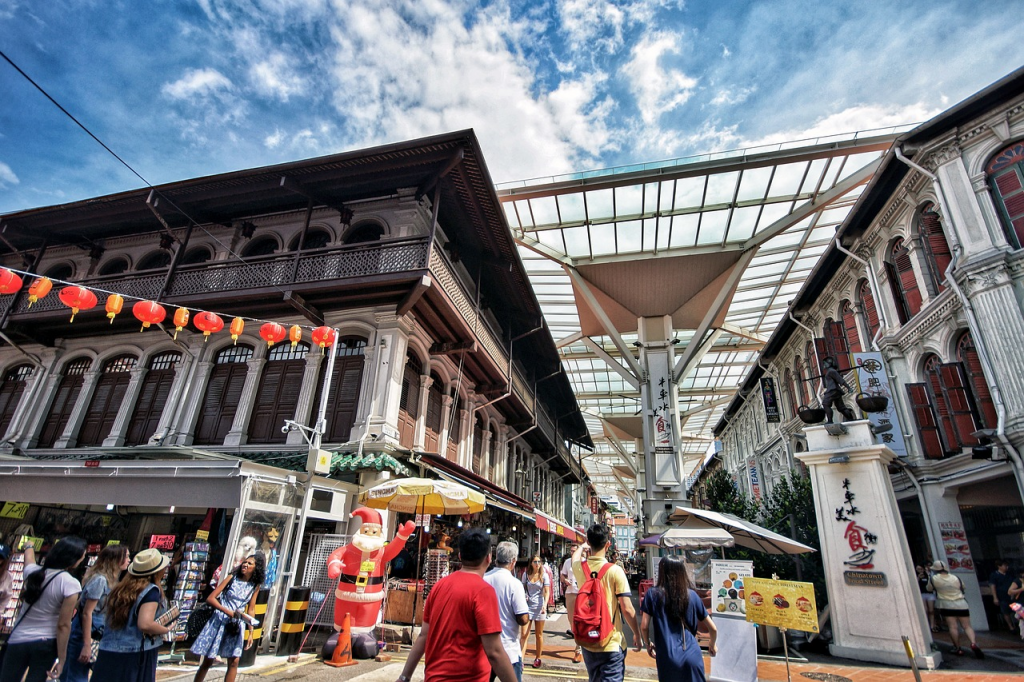
But hey! Do not even start thinking that this street food isn’t good or of doubt quality just because it is very very cheap. In 2016, indeed, a miracle (actually the second going on in our story) happened: two stalls located in the Hawker Centers of Singapore, the Hong Kong Soya Sauce Chicken Rice and Noodle and the Hill Street Tai Hwa Pork Noodle, received one of the much-desired Michelin stars. Afterwards, forty more stalls were awarded a star and also the Bib Gourmand (the award given to restaurants that offer great food at reasonable prices).
This extraordinary miracle was also recognized by UNESCO which, in 2020, added the Hawker Centers of Singapore to the Representative List of intangible Cultural Heritage of Humanity under the name of “Hawker Culture in Singapore: community dining and culinary practices in a multicultural urban context”. The Hawker Centers have been recognized as “community dining areas” for any pocket, where people of different social background gather to share the experience of food but also to enjoy shared seating areas where they can play, read or just faff about. The Hawker Centers also play a crucial role in enhancing the interactions of an extremely heterogeneous community, thus reinforcing a fragile social framework.
And now, let’s move on and talk about serious stuff. What food can be found in the Hawker Centers? It is quite difficult to define a local cooking due to east influences from China, Malaysia, India and Indonesia, which through the years have unavoidably blended with a more westernized flow. Among the most characteristic dishes of Chinese derivations, the Gai Lan, or broccoli in oyster sauce. The recipe consists in boiled Chinese cauliflower tops garnished with a thick sauce made with simple syrup and soy sauce, powdered onion, oyster sauce, sesame oil and finished with the inevitable sautéed garlic cloves.
Of Korean descent, the beefsteak is served raw on a red-hot plate placed on a wooden platter; the customer is free to personalize the cooking time between blue and well-done, by eating it immediately or leaving it to slow-cook on the heat. Standing ovation to the Tom Yum Soup, Thai-derived dish, prepared with shrimps, mushrooms, tomatoes, onions, garlic, ginger, lime juice and leaves, lemongrass, fish sauce, coriander, chili, red hot chili sauce, sugar and condensed milk (the latter ingredient introduced by the British in colonial times).
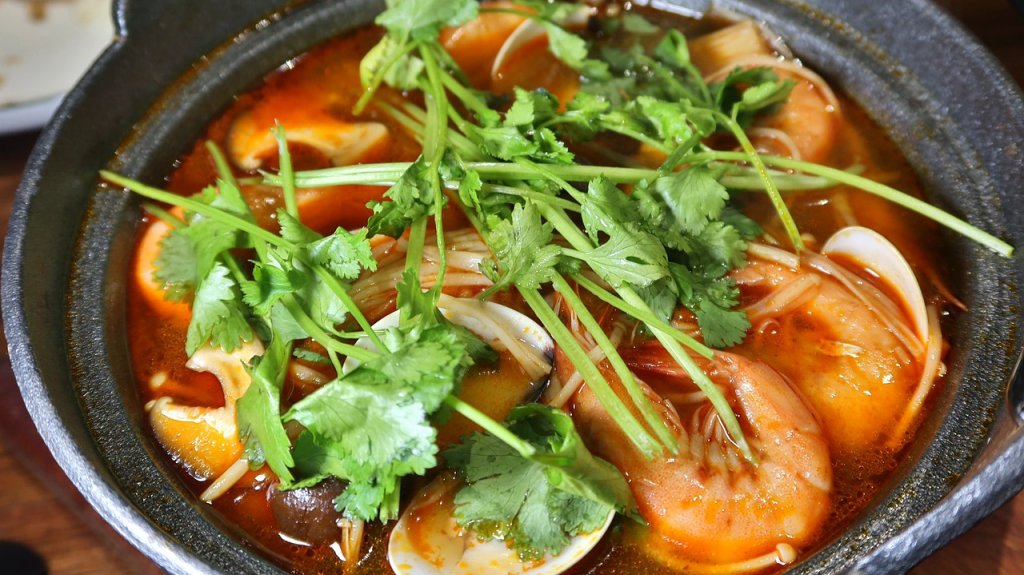
This soup is a real classic and it is served also outside the Hawker Centers; in the Orchard Towers, located in the Singaporean shopping avenue, you can certainly find one of the best. Although prostitution is illegal and homosexuality considered a crime, alongside the soup, the Orchard Towers offers kind “companies”, waiting to be bought for the evening with an expensive Lady Drink in the red-light bars of the Four Floors of Whores. A mix of Philippine music bands, Asian prostitutes and Thai Ladyboy, which brings us to mind the warm atmospheres of the unforgettable scene of the danse de couple, directed by Peter Bogdanovich in the movie Saint Jack: Shirley Bassey, with her sensual voice, on the notes of “Goldfinger” swings the dance between a platinum blonde Chinese and a Thai transgender. The show was a gift from Jack Flowers – together with a Cuban cigar and a Scotch whisky – to his Western guest as a warm welcoming to Singapore.
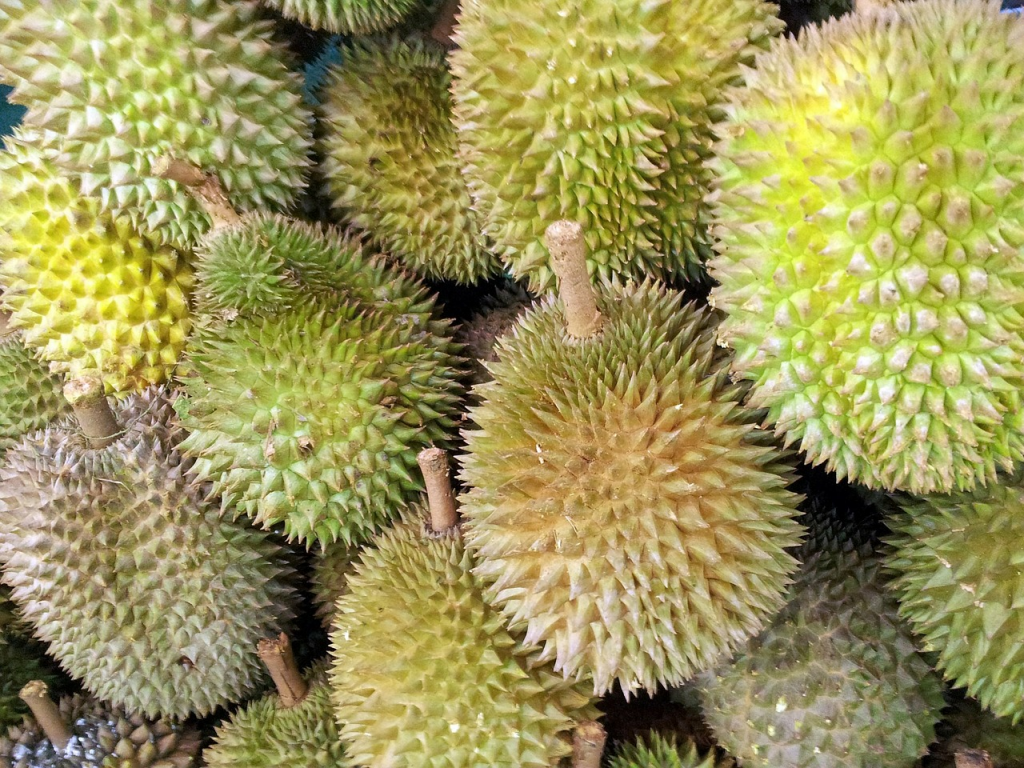
As for original local food, however, a few exceptions are worth of mentioning. The durian, for instance, is a tropical fruit characterized by a prominent feature, which overcomes all the others by an extra mile: the stench. The disgusting smell of this fruit costed an expensive toll: it cannot be carried on public transport or brought inside hotels. There is not much we can actually say about this funny fruit because it is rare to meet someone who dared to taste it (…or survived after such a dare!).
Fortunately, the name of the city of Singapore has been, however, associated to something tastier and more appealing. Ngiam Tong Boon was the bartender of the prestigious Raffles Hotel (the hotel named after Sir Thomas Stamford Raffles, the founder of the city of Singapore – 1819). In 1915, almost a century after the foundation of the city of Singapore, Ngiam invented the cocktail Singapore Sling.
Today, the cocktail is in the list of IBA classics; a well-done Singapore Sling needs Gin (invented in Italy), Heering Cherry Liqueur (Danish liquor), Triple sec (French distillate), Bénédictine (a digestive made in Normandy), Grenadine (pomegranate, fruit of South-Asian origin), lime juice (Asian citrus), pineapple juice (Caribbean fruit) and Angostura (a bitter made in Venezuela by the Prussian doctor Siegert). We undoubtedly gather the idea that Ngiam elaborated its Singapore Sling to pay honour to the cosmopolitan and multicultural character of Singapore!
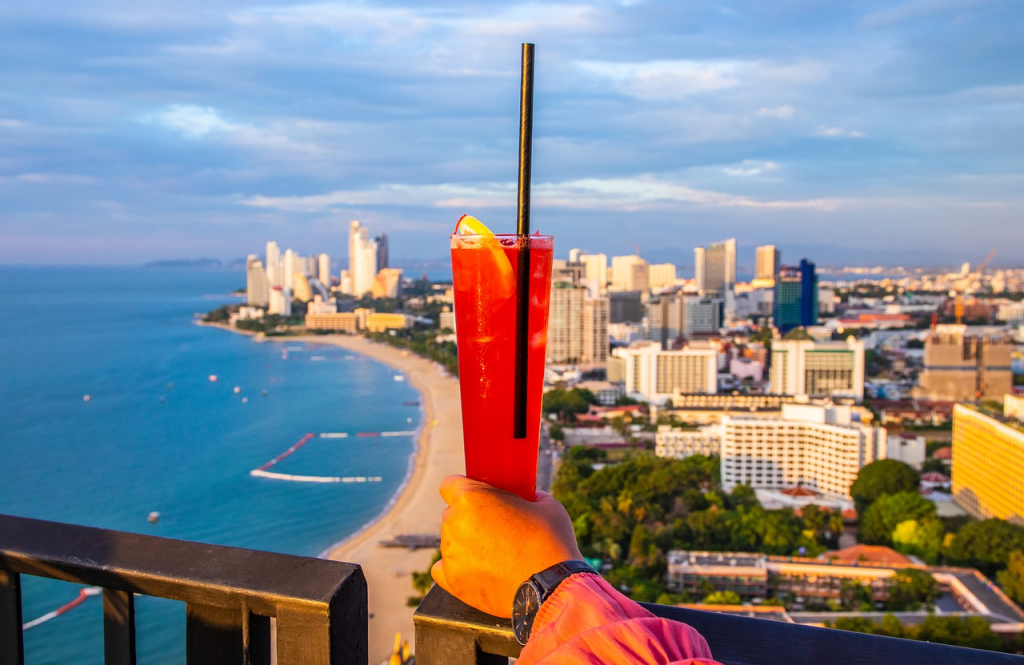
For its many contradictions and its unusual lifestyle, Singapore certainly requires a good open-mindedness and strong guts. Emerged from the fusion of multiple Far Eastern cultures and forged by severe British colonialism, the city has launched into a wild race to compete with the most powerful industrialized capitals in the world. In an effort to attract business and increase GDP, Singapore dazzles and enchants with its glittering attractions and the promise of a more modern world than modernity itself. Too bad, however, that around the corner, to put it in Bansky’s words, the dust keeps being hidden under the carpet! Singapore, indeed, clumsily tries to hide the trash that herself produces; the same waste that, however, collectively define such an irresistible cosmopolitan character.
In conclusion, Singapore is a city that opens new roads to the interpretation of urban phenomena and digs alternative underground tunnels to the impeccable perfection of the surface. From the cheapest Michelin-starred dish in the world and a Ladyboy as seductive as cheeky, in Singapore there is something for everyone’s taste!
Post scriptum. Once again, the unprecedented COVID-19 pandemic has imposed severe travelling restrictions to the author. This article was written thanks to the precious help of Mrs E. and Mister G, who collaborated by sharing their stories as direct witnesses and great connoisseurs of the city of Singapore, of its traditions and the inimitable street food. Mrs. R.’s wit has contributed to the interpretation of cosmopolitan phenomena. Thank you, guys!
English translation by Ester Badami
Head Image | Singapore, Skyline of Marina Bay Sands. (Source: https://pixabay.com/photos/city-singapore-marina-bay-sands-1283634/).
La Lady {Boy} del sud est asiatico
Che sia la Città del Leone o una Tigre Asiatica, un paese occidentalizzato o un melting pot orientale, Singapore è senza dubbio una città-stato cosmopolita, luogo in cui confluiscono culture, interessi e tradizioni diverse e dove si possono trovare risposte ad aspirazioni, desideri e sogni – anche inconfessabili!
Il cosmopolitismo, occorre ricordarlo, non è mai esente da frizioni e delusioni. La delusione di chi fa parte di quella buona metà della popolazione addetta alla manovalanza e ai lavori più umili che non può permettersi un alloggio in città ed è costretto, ogni sera ed ogni mattina, ad attendere lunghe ore alla frontiera con la Malesia per varcare a piedi il confine attraverso lo stretto di Johor.
O ancora le inevitabili frizioni tra popolazioni di origine cinese, malese, indiana e indonesiana che, dagli inizi del XIX secolo, confluirono nell’estremo lembo malese per popolare l’avamposto commerciale fondato sotto il protettorato britannico dalla Compagina inglese delle Indie Orientali e che oggi è divenuto uno dei porti più importanti al mondo.
Offuscando le tristi realtà dei lavoratori più poveri, l’immagine maggiormente veicolata della città è quella di chi gode della sua ricchezza e, se si pensa che nel 2009 Singapore è stata classificata come la metropoli con la più alta concentrazione di milionari, sono davvero molti! Per loro la città offre lavoro ben retribuito, servizi pubblici efficienti e svaghi in quantità; l’intera isola di Sentosa è un parco divertimenti, sia per bambini che per adulti.
Isola di Sentosa. Ponte sospeso tra Sentosa e l’isola di Palawan. (Fonte: https://pixabay.com/photos/sentosa-beach-singapore-rope-bridge-2525668/).
La calura del clima equatoriale è smorzata dall’ombra dei suoi avveniristici grattacieli, dai parchi urbani che sono vere e proprie foreste tropicali e dai lussureggianti Giardini botanici. La città seduce e incanta con il potere dei suoi visionari landmark, come il complesso di Marina Bay Sands progettato da Moshe Safdie con la piscina a sfioro più lunga e più alta del mondo e il Museo ArtScience a forma di fiore. Il governo provvede alla tranquillità e alla sicurezza dei cittadini attraverso rigidi regolamenti che disciplinano minuziosamente i comportamenti sociali: si va dalla pena capitale per i reati maggiori e il traffico di droga, a multe molto salate per chi gira in casa nudo o non tira lo sciacquone del water! Capita spesso di sentir dire ai singaporiani e agli expats che vi risiedono che sono così felici di vivere in questa città che non sentono il bisogno di andare altrove, affermando orgogliosamente di non volerla lasciare mai. Sembrano pienamente soddisfatti di una esistenza che, osservata a distanza, somiglia inquietantemente a quella di Truman Burbank, il protagonista di The Truman Show!
Singapore, Marina Bay Sands e ArtScience. (Fonte: https://pixabay.com/it/photos/singapore-marina-bay-sands-marina-5653556/).
Nel ritratto di Singapore, come purtroppo accade in tutte le grandi capitali, vi è quindi incisa una profonda frattura tra classi benestanti e gente povera, esacerbata dalla multietnicità della popolazione. Ma è proprio nelle situazioni più estreme che, a volte, si compiono i miracoli più straordinari. E qui il miracolo è stato compiuto dalla cucina!
Sebbene la città sia una delle più costose al mondo, è sorprendente scoprire che mangiare fuori sia molto economico, persino meno costoso di prepararsi un pasto a casa. Il fenomeno è dovuto alle innumerevoli bancarelle di ambulanti, presenti ovunque in città, che servono cibo da strada. Dalle undici del mattino alle undici di sera si possono gustare noodles, zuppe, riso, ravioli, spiedini; cibi arrostiti, cotti al vapore, fritti; spremute, dolci e frutta.
Dagli anni ’60 – da quando Singapore è divenuta una Repubblica indipendente – il fenomeno del cibo da strada è stato regimentato dal governo locale. Le bancarelle degli ambulanti, spesso senza acqua corrente, si presentavano infatti in condizioni igieniche assai precarie; animali randagi e parassiti contribuivano, dal canto loro, a peggiorare la situazione. Oltre ad introdurre degli standard di qualità, gli enti governativi hanno costruito, in più zone della città, i cosiddetti Hawker Center, strutture dedicate appositamente ad ospitare le bancarelle ambulanti, attrezzate di servizi igienici e di tavoli per gli avventori. Ogni giorno una moltitudine di gente, dai meno abbienti ai più facoltosi, dai lavoratori ai turisti, frequenta gli Hawker Center di Singapore dove, per pochi dollari, può scegliere dalle bancarelle multietniche le pietanze preferite da portare al primo tavolino disponibile e da gustare in mezzo alla folla di avventori.
Singapore, Chinatown Food Street. (Fonte: https://pixabay.com/photos/singapore-chinatown-3057916/).
Ma, attenzione! Non pensiate che il cibo delle bancarelle non sia buono o di scarsa qualità solo perché è molto economico. Difatti, nel 2016 è accaduto un altro miracolo: due bancarelle situate negli Hawker Center di Singapore, la Hong Kong Soya Sauce Chicken Rice and Noodle e la Hill Street Tai Hwa Pork Noodle, hanno ricevuto una delle ambitissime stelle Michelin. Successivamente, altre quaranta bancarelle sono state insignite dello stesso riconoscimento e del Bib Gourmand (conferito ai servizi di ristorazione che eccellono nel rapporto qualità-prezzo).
Questo straordinario miracolo è stato riconosciuto anche dall’Unesco che, nel 2020, ha inserito gli Hawker Center di Singapore nella lista del patrimonio immateriale dell’umanità con la denominazione di “Cultura del venditore ambulante a Singapore, ristorazione comunitaria e pratiche culinarie in un contesto urbano multiculturale”. Gli Hawker Center sono stati riconosciuti come “sale da pranzo della comunità”, dove persone di diversa estrazione sociale e capacità economica si riuniscono per condividere l’esperienza non soltanto del mangiare ma anche dello stare insieme per giocare, leggere o semplicemente passare del tempo. È stato così riconosciuto che gli Hawker Center svolgono un ruolo cruciale nel migliorare le interazioni di una comunità estremamente eterogenea e nel rafforzare il tessuto sociale.
Cosa si mangia negli Hawker Center? È difficile definire una cucina locale perché le influenze orientali della Cina, della Malesia, dell’India e dell’Indonesia si sono ormai fuse con quelle occidentali. Tra i piatti più caratteristici di derivazione cinese troviamo i Gai Lan, broccoli in salsa di ostriche, una ricetta che prevede l’utilizzo di cime di broccoli cinesi lessati e conditi con una densa salsa a base di zucchero disciolto in acqua calda e salsa di soia, cipolla in polvere, salsa di ostriche, olio di sesamo e guarniti con gli immancabili spicchi di aglio saltati.
Di derivazione coreana è invece la bistecca di manzo, servita cruda su un piatto rovente adagiato su un tagliere di legno; il commensale personalizza i tempi di cottura tra il bleu e il bien cuit mangiandola subito o lasciandola arrostire con calma. Grande successo riscuote la Tom Yum Soup, di origini thailandesi, preparata con gamberi, funghi, pomodori, cipolle, aglio, zenzero, succo e foglie di lime, lemongrass, salsa di pesce, coriandolo, peperoncini, salsa di peperoncino piccante, zucchero e latte condensato (quest’ultimo ingrediente introdotto dagli inglesi in periodo coloniale).
Tom Yum Soup. (Fonte: https://pixabay.com/photos/tom-yum-soup-tai-food-soup-6126147/).
La zuppa, un vero classico, viene servita anche in altri locali al di fuori degli Hawker Center; nella Orchard Tower, lungo la via dello shopping singaporiano, se ne gusta una delle migliori. Nonostante la prostituzione sia illegale e l’omosessualità considerata reato, oltre alla zuppa qui sono disponibili anche gentili compagnie, in attesa di farsi comprare per la serata con un costoso Lady Drink nei locali a luci rosse dei Four Floors of Whores. Un misto di band musicali filippine, prostitute asiatiche e Ladyboy thailandesi che ci riporta alle calde atmosfere dell’indimenticabile scena della danse de couple girata da Peter Bogdanovich: nel film Saint Jack, il regista ha affidato alla voce sensuale di Shirley Bassey il sottofondo musicale, sulle note di Goldfinger, su cui si muove la danza tra una cinese platinata e una transgender thailandese, spettacolo offerto dal protagonista del film Jack Flowers – insieme ad un sigaro cubano e ad un whisky scozzese – al suo ospite occidentale come benvenuto nella città di Singapore.
A rappresentare la cucina locale sopravvivono ancora alcune eccezioni, come il durian, frutto tropicale di cui la caratteristica – che sovrasta di gran lunga tutte le altre – è il fetore; la sgradevole fragranza del frutto è tale che gli è costata il divieto di salire sui mezzi pubblici e di entrare negli hotel. Su questo frutto non si può dire molto, perché è raro incontrare chi ha avuto il coraggio di mangiarlo!
Frutto del durian. (Fonte: https://pixabay.com/photos/singapore-durian-fruit-juicy-food-314915/).
Ad associare il nome della città a qualcosa di decisamente più appetibile ci ha pensato Ngiam Tong Boon, il barman del prestigioso Hotel Raffles (albergo dedicato a Sir Thomas Stamford Raffles, che fondò di Singapore nel 1819), che nel 1915, quasi un secolo dopo dalla fondazione della città, ha ideato la miscela del Singapore sling.
Oggi questo cocktail è inserito nella lista dei classici selezionati dall’IBA; per un buon Singapore sling occorrono Gin (distillato inventato in Italia), Heering Cherry Liqueur (liquore danese), Triple sec (distillato francese), Bénédictine (digestivo prodotto in Normandia), Granantina (il melograno ha origini nell’Asia sud-occidentale), succo di lime (agrume asiatico), succo di ananas (frutto caraibico) e Angostura (bitter elaborato in Venezuela dal medico prussiano dott. Siegert). Il nostro buon Ngiam con il suo cocktail avrà, senza dubbio, voluto rendere omaggio al carattere cosmopolita di Singapore!
Singapore sling. (Fonte: https://pixabay.com/photos/singapore-sling-cocktail-thailand-5947604/).
Per le sue mille contraddizioni e il suo inconsueto stile di vita, Singapore richiede decisamente una buona apertura mentale e viscere forti! Emersa dalla fusione di più culture dell’estremo oriente e forgiata dal severo colonialismo britannico, la città si è lanciata in una corsa sfrenata per competere con le capitali industrializzate più potenti del mondo. Nell’intento di attrarre business e incrementare il PIL, Singapore abbaglia e incanta con le sue sfavillanti attrazioni e con la promessa di un mondo più moderno della modernità stessa.
Peccato però che dietro l’angolo, per dirla con Bansky, la polvere sia stata nascosta sotto il tappeto! Singapore infatti goffamente tenta di occultare il sudiciume che lei stessa produce, quegli scarti di produzione che, tuttavia, concorrono a definire quel carattere cosmopolita così irresistibile. È così che a Singapore, città che apre nuove vie all’interpretazione dei fenomeni urbani e scava cunicoli sotterranei alternativi all’impeccabile perfezione della superficie, tra il piatto stellato più economico al mondo e una seducente quanto sfacciata Ladyboy, ce n’è per tutti i gusti!
Post scriptum. Ancora una volta, la pandemia COVID-19 ha imposto all’autore severe restrizioni di viaggio. Questo articolo è stato scritto grazie al prezioso aiuto della Sig.ra E. e del Sig. G. che hanno collaborato condividendo le loro storie come testimoni diretti e grandi conoscitori della città di Singapore, dei suoi costumi e del suo inimitabile cibo da strada. L’arguzia della Sig.ra R. ha contribuito all’interpretazione dei fenomeni cosmopoliti. Grazie amici!
Head Image | Singapore, Skyline di Marina Bay Sands. (Fonte: https://pixabay.com/photos/city-singapore-marina-bay-sands-1283634/).